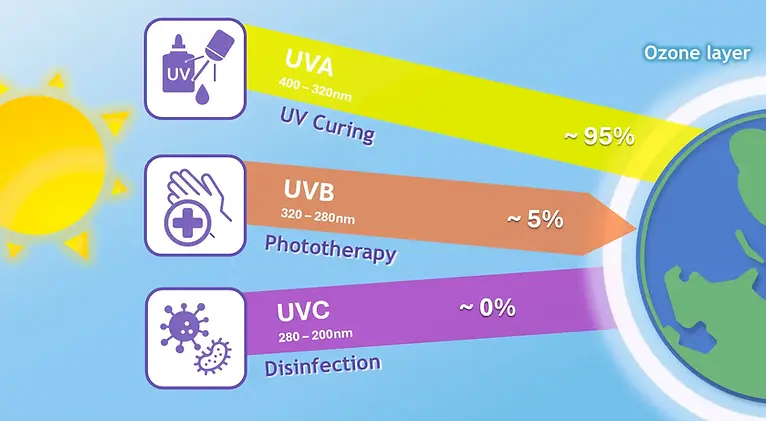What is UV?
A comprehensive understanding of the classification and application wavelengths of UV light.

Due to the filtering effect of the atmosphere and the ozone layer, approximately 95% of the ultraviolet (UV) radiation that reaches the Earth's surface is UVA, about 5% is UVB, and almost all UVC is absorbed by the ozone layer, preventing it from reaching the ground. (These proportions may vary slightly depending on the region and atmospheric conditions.)
UV light history and evolution
UV stands for Ultra Violet, representing light with a shorter wavelength than violet light that is invisible to the human eye. UV light has always been present in sunlight, but it was not until 1801 that a German scientist discovered its existence.
In 1878, people discovered that the ultraviolet radiation in sunlight had germicidal and disinfectant properties.
In 1901 and 1906, humans invented the mercury arc, an artificial UV light source, and the quartz tube that transmitted UV light more efficiently, respectively, officially opening up the use of artificial UV light sources.
In recent years, new UV light sources have been invented, such as UV LEDs and excimer UV lamps.
UV (Ultraviolet)

Types of UV Light
UV light can be classified into UVA, UVB, and UVC based on their wavelengths.
Currently, commercial UV LED can cover all wavelengths above 250nm. The three types of UV light have different applications. UVA is mainly used for drying and curing in the industrial field, UVB is commonly used for treating various skin diseases, while UVC is mainly used for disinfection and sterilization.
Type | Wavelength Range | Characteristics | Effects | Applications |
|---|---|---|---|---|
UVA
| 320–400 nm | Longest wavelength Strong penetration, can pass through clouds and glass, reaching the dermis layer of the skin | Causes skin aging and wrinkles, increases the risk of skin cancer. | Tanning lamps, medical treatment, UV adhesive curing, inspection equipment. |
UVB | 280–320 nm | Medium wavelength Partially absorbed by the atmosphere, mainly affects the surface layer of the skin | Main cause of sunburn, long-term exposure increases cancer risk | Promotes human synthesis of vitamin D, treatment of psoriasis, eczema, plant growth, and food preservation |
UVC | 100–280 nm | Shortest wavelength Highest energy, but almost completely absorbed by the Earth's ozone layer and cannot reach the ground | Artificial UVC should be avoided, as it may damage the skin and eyes | Germicidal lamps, air disinfection, accelerated aging of alcoholic beverages, and inhibition of cancer cell growth |

How Is UVC Light Generated?
UVC light possesses excellent germicidal properties. However, because this wavelength range is almost entirely absorbed by the ozone layer before reaching the Earth, it cannot be obtained directly from natural sunlight. With technological advancements, artificial methods have been developed to generate UVC light sources.
There are three main technologies for generating UVC:
Mercury Lamp Technology
This method uses low-pressure mercury lamps that primarily emit ultraviolet light at 254 nm. Due to environmental concerns regarding mercury, this technology is gradually being phased out.
- A mature and widely adopted technology
- Relatively low cost
UV LED Technology
Emits specific ultraviolet wavelengths through semiconductor materials such as AlGaN. The manufacturing cost is high, and the efficiency still needs improvement.
- Long lifetime and mercury-free, environmentally friendly
- Customizable multi-wavelength options
Excimer Lamp
A type of gas discharge lamp that generates ultraviolet radiation through spontaneous emission from excited dimers. It is particularly used in fields such as semiconductor manufacturing, biomedical applications, and environmental sciences.
- High ultraviolet light emission efficiency, suitable for large-area irradiation
- Operation and startup are not affected by ambient temperature
Common Industrial Applications of UV LEDs

UVC Disinfection Principle
UV light can destroy the DNA or RNA molecular structure of microorganisms, causing them to die or be unable to reproduce, thus achieving the purpose of sterilization and disinfection.
Germicidal Disinfection:254 nm vs. 265 nm Wavelengths
-
254 nm is the standard wavelength emitted by traditional low-pressure mercury lamps, with high DNA absorption efficiency.
-
265 nm is closer to the DNA absorption peak and offers better material penetration, making it more suitable for a wide range of disinfection applications.
The optimal sterilization wavelength is around 265nm
So 265nm UVC LED is currently the most effective light source for sterilization. Other UVC wavelengths also have sterilization effects, but the farther away from 265nm, the decrease in effectiveness and more energy is required to achieve the same sterilization power.
To quantify the amount of UV light
The commonly used unit is the dose, measured in J/cm^2.
Dose = UV radiation intensity (W/cm^2) x time (sec). The required dose for sterilization for each microorganism can be verified through experiments, but UVC LED is a relatively new technology, and most experimental data is still based on UV mercury lamps.
222nm UV excimer lamp
In recent years, a new 222nm UV excimer lamp has emerged. Due to the characteristics of this wavelength, it causes less damage to the human body than other sterilization lamps. However, its sterilization efficiency is still not as good as the 265nm light source, and the lifespan and price of the excimer lamp are not ideal, so it has not yet been widely used in the sterilization application market.


